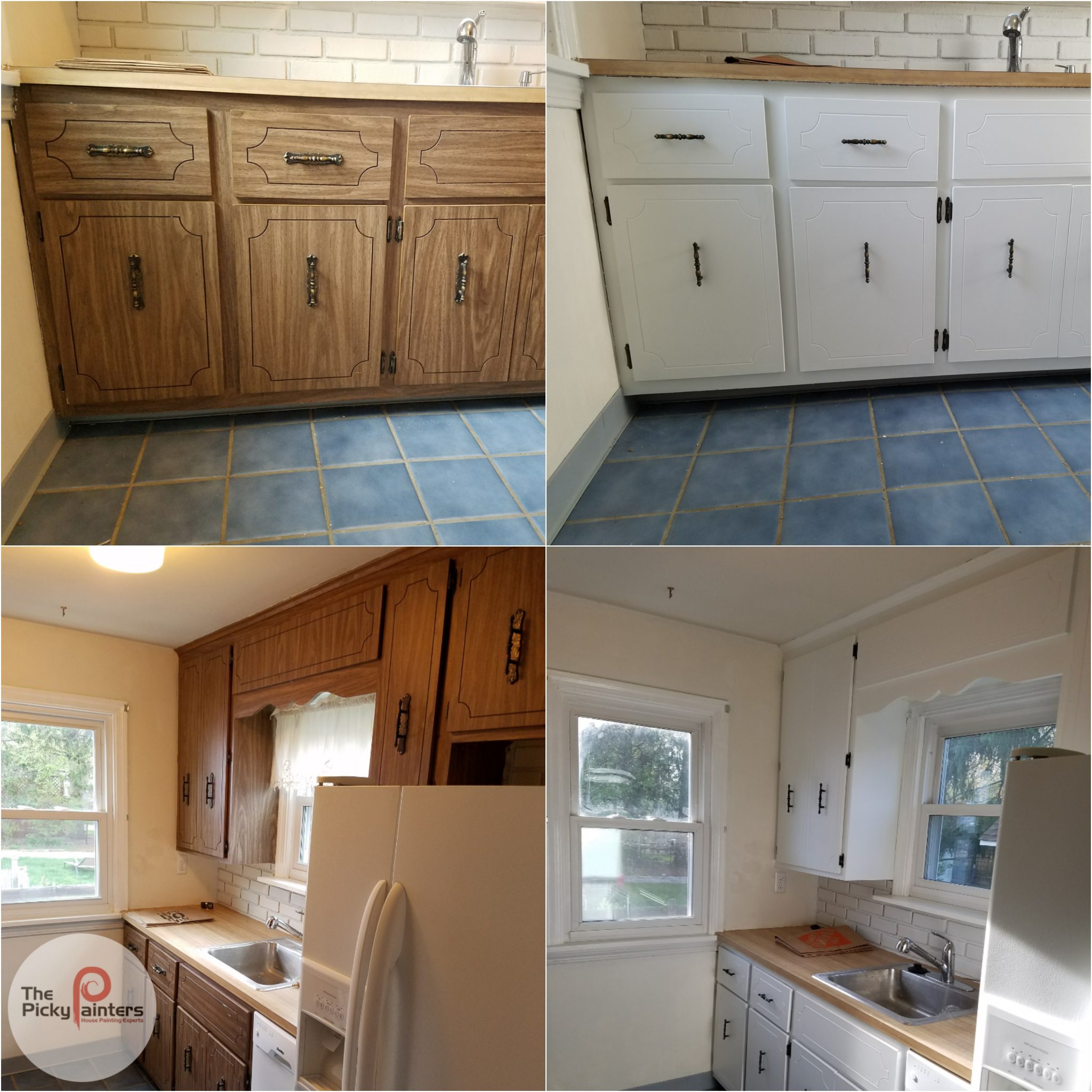Surface Preparation for Painting Laminate Cabinet Doors

Proper surface preparation is paramount for a successful paint job on laminate cabinet doors. Failing to adequately clean, sand, and prime the surface will result in poor paint adhesion, chipping, and an overall unsatisfactory finish. This section details the crucial steps involved in preparing your laminate cabinet doors for painting, ensuring a durable and professional-looking result.
Cleaning Laminate Cabinet Doors
Thorough cleaning removes grease, grime, and other contaminants that can interfere with paint adhesion. This step is critical for achieving a smooth, even paint finish. Different cleaning agents are suitable for various types of grime; choosing the right one is important. The following table Artikels appropriate cleaning agents, application methods, and safety precautions:
| Cleaning Agent | Application Method | Safety Precautions | Drying Time |
|---|---|---|---|
| Warm soapy water | Apply with a soft sponge or cloth, gently scrubbing. Rinse thoroughly with clean water. | Avoid excessive scrubbing which could damage the laminate. Wear gloves if desired. | 5-10 minutes |
| Degreaser (e.g., TSP substitute) | Dilute according to product instructions. Apply with a soft cloth, working in small sections. Rinse thoroughly. | Always follow manufacturer’s instructions. Wear gloves and eye protection. Work in a well-ventilated area. | 15-20 minutes |
| Isopropyl alcohol (rubbing alcohol) | Apply with a clean cloth, wiping gently. No rinsing required. | Flammable. Keep away from open flames and sparks. Work in a well-ventilated area. | 5-10 minutes |
After cleaning, allow the doors to dry completely before proceeding to the next step. Ensure all surfaces are completely dry to prevent trapping moisture under the paint.
Sanding Laminate Cabinet Doors
Sanding creates a slightly rough surface, improving paint adhesion. However, it’s crucial to avoid excessive sanding, which could damage the laminate. Use a fine-grit sandpaper (220-grit or higher) and sand lightly in the direction of the wood grain (if visible). Focus on smoothing any imperfections rather than aggressively removing material. For stubborn imperfections, start with a slightly coarser grit (180-grit), but always finish with 220-grit or finer to create a smooth surface. Use a sanding block to maintain even pressure and avoid creating scratches.
Priming Laminate Cabinet Doors
Priming is a vital step that ensures optimal paint adhesion and prevents the laminate’s surface from showing through the final coat of paint. A high-quality bonding primer specifically designed for laminate surfaces is essential. Oil-based primers offer excellent adhesion but require longer drying times, while water-based primers dry faster and are easier to clean up. Apply a thin, even coat of primer using a high-quality brush, roller, or spray gun. Allow the primer to dry completely according to the manufacturer’s instructions before applying paint. Multiple thin coats are better than one thick coat to prevent drips and runs. For best results, lightly sand the primed surface with a very fine-grit sandpaper (320-grit) before painting to achieve a perfectly smooth finish.
Paint Selection and Application Techniques for Laminate Cabinet Doors: How To Paint Over Laminate Cabinet Doors

Choosing the right paint and applying it correctly is crucial for a durable and aesthetically pleasing finish on your laminate cabinet doors. The surface’s unique properties require a paint that adheres well and resists chipping or peeling. Proper application techniques ensure a smooth, even coat that enhances the cabinets’ appearance.
Paint Types Suitable for Laminate
Selecting the appropriate paint is paramount for a successful paint job on laminate. Different paint types offer varying levels of adhesion, durability, and ease of application. Understanding these differences will help you choose the best option for your project.
- Acrylic Paint: Acrylic paints are water-based, making them easy to clean up. They offer good adhesion to properly prepared laminate surfaces and are available in a wide range of colors and finishes. However, they might require multiple coats for full coverage and may not be as durable as other options in high-traffic areas. They are generally a good choice for beginners due to their ease of use and cleanup.
- Alkyd Enamel Paint: Alkyd enamel paints are oil-based and offer superior durability and hardness compared to acrylics. They provide excellent resistance to scratches and chipping, making them ideal for high-use areas like kitchen cabinets. However, they have a strong odor, require mineral spirits for cleanup, and may take longer to dry. Their superior durability often justifies the extra effort.
- Shellac-Based Paint: Shellac-based paints offer a hard, smooth finish with excellent adhesion. They are known for their ability to seal and protect the underlying surface. However, they are less durable than alkyd enamels and require careful application to avoid brushstrokes. Their fast drying time can be an advantage or disadvantage depending on your skill level.
- Specialty Laminate Paints: Specifically formulated for laminate surfaces, these paints often contain bonding agents that improve adhesion. They are designed to overcome the challenges of painting laminate and offer superior results compared to standard paints. These are usually more expensive but can significantly improve the final result.
Step-by-Step Paint Application
Achieving a professional-looking finish on laminate requires careful and methodical application. These steps will help you achieve even coverage and minimize brushstrokes.
- Prepare the surface: Ensure the laminate is thoroughly cleaned and degreased. Lightly sand with fine-grit sandpaper to create a slightly rough surface for better paint adhesion. Remove all dust with a tack cloth.
- Prime the surface (optional but recommended): A high-quality primer specifically designed for laminate will improve paint adhesion and ensure a more even finish. Allow the primer to dry completely according to the manufacturer’s instructions.
- Apply the first coat of paint: Use thin, even strokes, working in the same direction. Avoid overloading the brush or roller. Allow the first coat to dry completely.
- Sand lightly (optional): If necessary, lightly sand the first coat with fine-grit sandpaper to smooth out any imperfections. Remove all dust with a tack cloth.
- Apply subsequent coats: Apply additional coats as needed to achieve full coverage and desired opacity. Allow each coat to dry completely before applying the next.
Paint Application Methods Comparison
Different application methods offer varying levels of control, speed, and finish quality. Choosing the right method depends on your skill level, the size of the project, and the desired outcome.
| Application Method | Pros | Cons | Best Use Case |
|---|---|---|---|
| Brush | Precise control, good for detail work, relatively inexpensive | Can leave brushstrokes, labor-intensive for large areas | Small projects, detailed work, achieving specific textures |
| Roller | Fast coverage, good for large areas, relatively inexpensive | May leave roller marks, less precise control than a brush | Large cabinet doors, achieving a smooth finish with multiple coats |
| Spray | Fastest coverage, smooth, even finish | Requires specialized equipment, can be messy, potential for overspray | Large projects, achieving a perfectly smooth finish, professional-looking result |
Addressing Common Issues and Advanced Techniques

Painting laminate cabinet doors successfully hinges not only on proper preparation and application but also on understanding and addressing potential problems. This section details techniques to prevent common issues and achieve a professional, long-lasting finish. We’ll explore strategies to mitigate peeling, chipping, drips, and uneven coverage, along with advanced methods for creating unique effects.
Preventing Paint Peeling and Chipping, How to paint over laminate cabinet doors
The key to preventing paint from peeling or chipping on laminate is meticulous surface preparation. A poorly prepared surface is the most common cause of paint failure. Remember, laminate is a non-porous surface, and paint needs something to adhere to. Therefore, proper cleaning, sanding, and priming are paramount.
Proper cleaning removes grease, grime, and any existing coatings that could interfere with adhesion. Use a degreaser and a clean cloth, rinsing thoroughly and allowing to dry completely.
Light sanding with fine-grit sandpaper (220-grit or higher) creates microscopic scratches, providing a better mechanical bond for the primer and paint. Focus on scuffing the surface, not removing it.
A high-quality bonding primer specifically designed for laminate surfaces is crucial. This primer acts as a bridge between the laminate and the topcoat, significantly improving adhesion and durability. Apply two thin coats, allowing each to dry completely before applying the next.
Managing Drips, Runs, and Uneven Coverage
Drips and runs are often caused by applying paint too thickly. Uneven coverage can result from insufficient stirring, poor application technique, or using a low-quality brush or roller.
Always stir your paint thoroughly before each use to ensure even pigment distribution.
Apply thin, even coats using smooth, controlled strokes. Avoid overloading your brush or roller.
Use a high-quality brush or roller designed for the type of paint you’re using. A good-quality tool will leave a smoother, more even finish.
Work in small sections, ensuring each area is fully covered before moving on to the next. This helps to prevent drips and runs.
If a drip or run occurs, allow the paint to dry slightly, then carefully sand it smooth with fine-grit sandpaper before applying another thin coat.
Advanced Painting Techniques for Professional Finishes
Achieving a professional finish on laminate requires attention to detail and the use of appropriate techniques. Beyond a simple smooth finish, you can explore methods for creating unique looks.
Creating a Distressed Look
A distressed finish adds character and charm. This technique involves layering paint colors and then selectively removing portions of the top coat to reveal the underlying layers.
Apply a base coat of a darker color. Allow it to dry completely.
Apply a lighter top coat. Don’t worry about perfect coverage; some variation is desirable.
Once the top coat is dry, use fine-grit sandpaper to lightly sand away portions of the top coat, revealing the darker base coat beneath. Focus on edges and corners for a more authentic distressed appearance. You can use various tools like steel wool or even a wire brush for different levels of distressing.
Apply a clear sealant to protect the finish.
Creating a Two-Tone Finish
A two-tone finish adds visual interest and can be used to highlight certain features of your cabinet doors. This technique involves applying two different colors in a strategic manner.
Choose two colors that complement each other.
Apply the base coat to the entire surface. Allow it to dry completely.
Using painter’s tape, carefully mask off the areas you want to remain the base color.
Apply the second color to the unmasked areas. Remove the tape while the paint is still slightly wet to prevent pulling up the paint underneath.
Apply a clear sealant to protect the finish.
